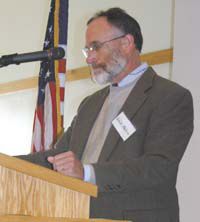| Patrick Malone. |
Patrick Malone came to the third annual Castle Valley Summit with 27 years experience in the field of community and economic development. Malone was the keynote speaker during the breakfast at the summit which was held at the Museum of the San Rafael.
He began his speech with a quote from George McLean of Tupelo, Miss. “There is no Santa Claus in Castle Dale, Price or Washington D.C. or anywhere else for our communities. If you want a better community, you will have to have to do it yourself. If you don’t do it, it will never get done,” Malone quoted McLean. McLean made this statement in the 1940s.
Malone went on to explain the framework of basic community economic development. The first phase is town building, This consists of installing the essential community infrastructure, including education. A portion of this first phase is the human assets of a community. “I believe it is the responsibility of the educated people to help raise the level of their community, economically, educationally, and culturally,” Malone said.
This phase must include building physical and human infrastructures. If this phase is done successfully, a good educational system for all will be included. Infrastructure is the foundation of economic development.
Phase two of his plan is to weave together all human, social and physical community assets and forge community trust, leadership, collaboration and social structures. This phase depends on community organization. Each community must have goals and work together to achieve those goals. If the community is closely linked with another community, each must have shared goals and participate in activities to attain the goals.
Strong leadership and social structures are very important in phase two. During this phase, all resources, including neighboring communities is essential. “In my experience, very few communities are functioning at this level,” Malone stated.
In phase three, which is the highest stage of community evolution, entrepreneurship is stressed. Everyone who wishes to open a business or expand a current business should be encouraged. Communities must be encouraged to stop copying others and search inside themselves for new things. “In this level, I’m suggesting a community culture of entrepreneurship,” said Malone.
“Many, too many communities, and rural communities, are organized around business recruitment. Only 1 percent of all new jobs come from business recruitment or relocation. Ninety nine percent of new jobs come from existing business expansion or business start-ups,” Malone stated. Most communities look to the outside world for business opportunities instead of focusing on the retention of businesses already in existence in that community.
“Far too often people overlook the possibilities already in their communities. Our responsibility is to reverse past trends. We cannot continue to work harder, we must begin to work smarter,” stressed Malone. “Weaving together effective and sustainable community economic development strategies requires strong leadership development, human organization and social development.”
“Most communities are stuck in phase one, they need something to save them. Those at level three still need attention. Change is our only constant,” Malone stated.
Malone went on to give examples of five communities who have made the successful transition to being healthy communities economically. With these examples, Malone explained that each community tapped into its strengths, identified its weaknesses, and worked together to solve the problems. Each inventoried their assets and built plans to capitalize on the infrastructure already in place.
The communities, two in Washington, one in Oregon, one in Mississippi, and one in Iowa, followed the outline to become successful. Each of these communities were serious in their commitment for success and economic development. Following the formula of leadership, organization, community spirit, community involvement, community assessment and focusing on the job at hand, made each one a success story.
One of the guiding principles to success is that locals must address local problems. This principle fits in with the strong leadership and looking inside for help. The solution to economic development comes when communities look within and not outside for answers.
“Not long ago nine out of 10 Americans were self employed. They knew how to sustain themselves. As with the town in Iowa, we need to create a new generation of entreprenuers. There are many support leagues or associations for entreprenuers, and I recommend getting involved with one of those networks. Being an entrepreneur is more about skill building. Most entrepreneurs are built, not grown.
“Ninety percent of what entrepreneurs learn, they learn from their peers, and they all need successful role models. Every entrepreneur should learn to redefine failure as a step for motivation,” Malone concluded.

